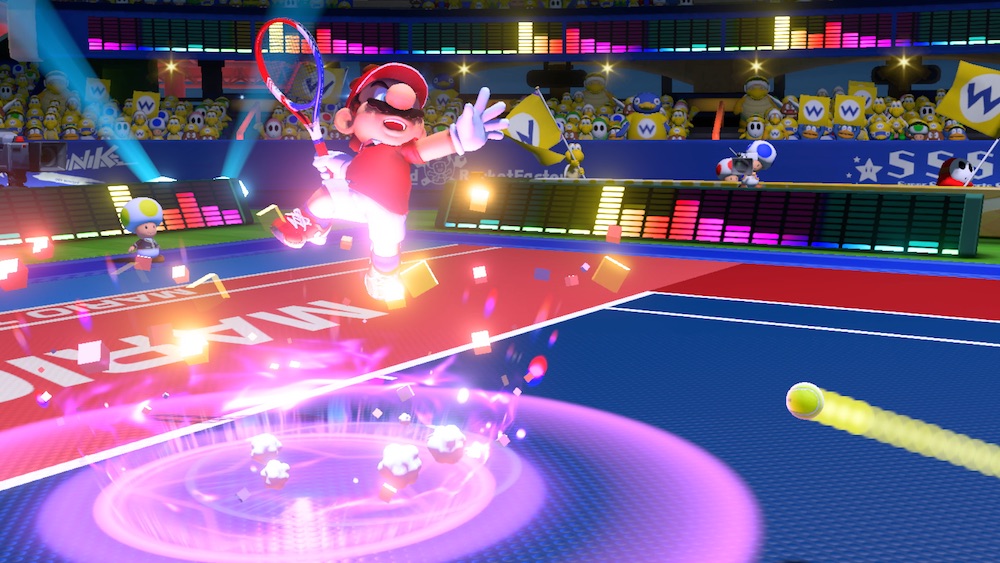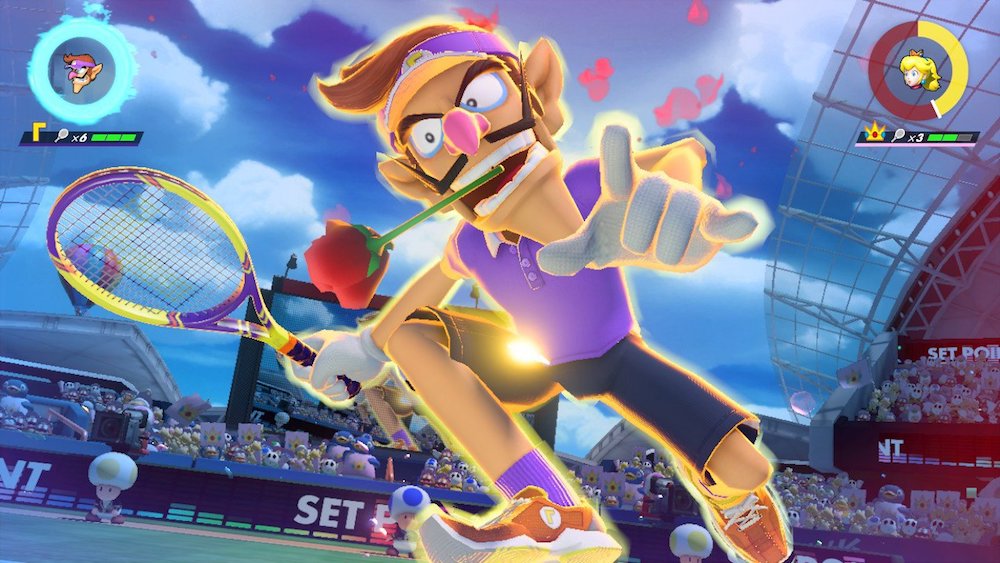
I always enjoy the Mario sports games. I’d play Super Mario Strikers over FIFA any day and can’t imagine ever playing a PGA Tour game when Mario Golf exists. These games don’t just consider “What is tennis like?” and attempt to represent their answer, they ask “What would make tennis even more fun?”. The more they commit to this approach the more I enjoy the game – when they build a game around a sport rather than building a sport within a game. The game that really whet my appetite for this stuff was Mario Tennis: Power Tour on the GBA, which was basically a 16-bit RPG with tennis matches and challenges in place of typical battles. That appetite has not been quenched since. Imagine my excitement, then, with the announcement of Mario Tennis Aces; a new Mario Tennis game with an adventure mode featuring role-playing systems.

The adventure mode isn’t all that drew me to Aces, though. The fundamentals of tennis are accessible and satisfying to master in Aces. Tricking your opponent with a well-placed drop shot or positioning just right to really wind up a charge shot they couldn’t hope to stop are some of the simple joys that emulate the fun of real tennis in easy to execute ways. Moving around the court feels responsively fluid, yet moving into position to return the ball takes forethought against competent opposition. Everything necessary to make a fun tennis game is present and exceptionally executed here, but the mechanics go far beyond the necessary.
Each player has an energy gauge in Aces which fills and depletes with their use of special moves. It’s this system and the resource management that comes with it that create the arcadey vibe of Aces. Rallies escalate into fighting game style competitions of using the right moves at the right opportunities, and returning the ball isn’t only about the positioning of yourself and your hit, but what can net you the most energy. Committing to your swing early for a Charge Shot is a simple way to fill your gauge, but successfully pulling off a Trick Shot – a cross-court leap – will rake in a far healthier yield. Time your Trick Shot poorly though, and you’ll spend some energy, even if you make the return. Every hit is an opportunity to fill your gauge, with the riskier techniques offering the most significant rewards. You can play it safe and keep it simple – just keeping a rally going will offer a little juice – but if your opponent is stocking up on energy quickly and you’re not, you’ll find yourself in a substantial disadvantage.

That’s because of the nifty tricks that energy lets you pull off. Slowing time with Zone Speed to reach a distant ball can save you many a point, while Zone Shots let you aim a super strong hit precisely. Better yet, a full meter can be spent on a Super Shot, basically letting a player take a Zone Shot from anywhere on the court with their character’s signature move. An immaculately aimed shot is, of course, easier to get past the competition, but these hits also add an additional layer of strategy; your racket has durability. Returning a Zone Shot or Super Shot takes a precisely timed Block, which will build some good energy, but any less than perfect and your racket will take some severe damage, often times breaking with one sloppy defence. This is where Aces makes a full commitment to its fighter influences. Not only can you win a match via traditional tennis rules, but a player can lose by KO. Once all of a player’s rackets have been destroyed, they’ve lost the match.
Having these dual objectives in each match means the dynamic of power can shift dramatically according to each player’s approach. You could be full sets ahead in the score but down to your last racket – you can be closer to losing even while closer to winning. This is what gives Aces its most exciting quality; you’re always playing two games at once. Yeah, if you can make that block you might get the point and a load of energy to cash out with later, but if you don’t and your racket breaks you’re one step closer to an instant loss. Maybe it’s better to just let them have the point and save yourself the risk? It’s a system that encourages thoughtful strategising throughout the course of an entire match, rather than playing point-by-point, and it adds a lot to every match.

The Adventure mode is what piqued my interest, though, and it’s certainly a focus of the game. The game opens on Adventure Mode before even the main menu, and it feels like a much more central component to the game than these kinds of modes tend to in recent years. As Wario and Waluigi show up with an ancient, evil tennis racket that possesses them along with poor Luigi, it’s up to Mario to gather the five Power Stones before they can. Typical silly sports game story, sure, but it’s nice to have a well-presented adventure to play with some pretty cutscenes and a reason to travel the map.
Adventure Mode sees Mario exploring this expectedly tennis obsessed island, competing in tennis matches or tennis-based challenges to overcome opponents and obstacles. Working your way through the different environments and playing on the corresponding courts is fantastic. Being able to compete in a piranha plant jungle, a haunted mansion or onboard a ship is a lot of fun and the kind of simple scene-setting that can do a lot to elevate the silliness and diversify what could be considered repetitive. Extra elements on these courts like piranha plants that catch and spit out shots or the ships mast inconveniently standing in the middle of the court mean each requires an extra consideration or two. Beating these levels in Adventure Mode is the condition to unlock them for multiplayer modes, so there’s some incentive to stick with the story, too.

The challenges outside of the tennis matches are where things can get a little dicey. They’re all fun ideas that find a great mix of tennis stuff and Mario stuff – like returning piranha plants’ fireballs to defeat them – and the boss fights can be especially engaging. Deflecting enemy attacks to build up enough energy to strike a weak point is a delightful, albeit simple approach to bigger encounters. The problem is, the difficulty really ramps up out of nowhere, requiring near flawless attempts to succeed. The random difficulty spike in the middle of adventure mode is a considerable count against the jolliness of Aces, but I think the way levels are failed may be the more fundamental issue.
Boss fights and challenge levels have you depleting a health bar or fulfilling a condition a certain number of times, and the fail state for these levels is expending the time limit. Playing flawlessly against a boss is sometimes enough to best it with a second or two remaining, so though they’re not necessarily super challenging to defeat, there’s just no room for error. As the clock counts down, it’s easy to find yourself in the middle of a challenge in a position where it is simply impossible to be victorious. There’s just not enough time left. When you’ve got minutes left on the clock but know you’ve already made too many mistakes to possibly win, why keep going? Of course, the sensible approach is to restart the level, but here’s the thing; quitting out of a level, skipping through the failure dialogue, selecting the level again, skipping through the introductory dialogue and finally loading the thing takes a while. It’s not forever, but it’s a tremendous oversight that there’s no option to try again mid-game when it’s so easy to have failed so long before the level is finished.

I haven’t touched on the levelling system in Aces yet, and unfortunately, there isn’t much to say. Playing Adventure Mode levels gives Mario some experience points that bump up his stats over time. It’s nice to have the player character grow through the game, rewarding those who take optional routes as well as the primary levels, but it comes off as shallow without any player input into Mario’s strengths or weaknesses. There are additional rackets to be earned, too, unlocked by besting some of the optional challenges throughout the map. Each racket gives a different stat boost and, more importantly, adds a next option if a racket is destroyed mid-game. They’re essentially lives, so their value is considerable. This is all a great step towards an engaging single-player mode, but the bare-bones extent of the RPG systems leaves the progression feeling pretty thin.
Multiplayer options are a lot more traditional, and a little disappointingly less creative. You can play against friends or CPUs in Free Play, take part in a local or online Tournament, or play with motion controls in Swing Mode. The tournament mode is a genuinely excellent implementation of online multiplayer, that simply and naturally allows ongoing tournaments to be participated in at any time, without any obligations. This is because the full bracket isn’t established ahead of time, but rather as the tournament progresses. If you’ve beaten two opponents, Aces will match you with a player who’s done the same, filling your bracket with their bested opponents and theirs with yours. It means that tournaments are fair, matching players according to their progress and upping the stakes as you get closer to the finals. Lose a match, and you’re out; start a new tournament and play against someone in the same boat. It’s not a complicated idea, but it’s an incredibly effective one executed pretty flawlessly.

Swing Mode isn’t so cool. Emulating Wii Sports’ motion features but incorporating some of Aces’ more involved mechanics and allowing for manual player movement sounds like a win on paper, but I found it to be more of a swing and a miss. The Joy-con motion controls just didn’t work very accurately for me, resulting in mostly mistimed swings and shots flying out. Swing Mode could have been an awesomely accessible option for Ace’s wonderful tennis, but it just doesn’t function well enough to be enjoyable.
Another bummer is the lack of any kind of progression outside of Adventure Mode. Earning different usable rackets as you do vehicles in Mario Kart 8 would have been more than enough, for instance, but all you’re earning for your online victories is an increasing number. The only unlockable characters are earned by partaking in a tournament each new month, which is kind of neat, but there’s just no incentive to keep playing until then.
Worth noting is the usual Nintendo audio-visual pop. The characters and environments are joyfully boisterous, and the score is triumphant and motivating. These are the things that make these games so much fun in a multiplayer setting for so long, they’re just pleasant to be amongst. It’s the little touches, like each character’s victory animation that plays as they land a point, letting the player move freely as they take in their win. An argument could be made that Super Shot animations play out for too long, and that’s fair, but the brief respite is an extra reward for filling that energy gauge, and the spectacle can still add a bit of fun.

Mario Tennis Aces is an exceptional tennis game at its core, with fun additional layers to keep things interesting. The inclusion of Adventure Mode is also very much appreciated, adding a good little set of more varied objectives to reach. The limited levelling system and frustrating difficulty issues of the single-player, on the other hand, leave it falling short – albeit on a great trajectory. For anyone who’s into Mario Tennis or even just likes the idea, this is a great one. For anyone who isn’t sold, I can’t see this changing their mind.











